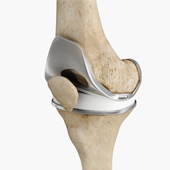Dr. Daniel Chan is an expert and knee replacement and reconstruction. He utilizes the latest techniques and instrumentation to achieve a minimally-invasive and well-balanced knee replacement and is a leader in South Florida for outpatient surgery in an ambulatory surgical center. He also employs the latest technology including robotic assisted knee replacement with the Velys Robotic Knee System. Dr. Chan also utilizes a minimally-invasive, quadriceps muscle-sparing approach for knee replacement to facilitate faster recovery and less post-operative pain. As an orthopaedic trauma specialist, Dr. Chan also is an expert in complex knee fracture reconstruction and also performs revision (re-do) knee replacement surgery where patients have had failed prior hip replacements. Please see below for additional information on relevant knee conditions and procedures.


Dr. Daniel Chan performs a completely quad muscle-sparing sub-vastus (right image) knee replacement, which avoids cutting any of the tendon or muscle around the knee that is done in traditional knee replacements using a medial parapatellar (left image) or mid-vastus (middle image) approach. This anatomic approach facilitates early recovery of range-of-motion and muscle strength, can decrease post-operative pain, and can lead to better long-term results.
Dr. Daniel Chan Explains New Technology for Precision Knee Replacement
The award-winning surgeons at Memorial Orthopaedic Surgery and Sports Medicine Center are the first in South Florida to use the VELYSTM Robotic-Assisted Solution, a technology that helps them perform knee replacement surgery tailored to each patient's unique anatomy to increase mobility, decrease pain and minimize recovery time, so patients can confidently return to their normal, active lifestyle sooner.
- Anatomy
- Conditions
- Procedures
Robotic Assisted Knee Replacement

Robotic-assisted knee replacement surgery is an alternative to the conventional knee replacement procedure. It is performed using robotic-arm technology that allows your surgeon to precisely perform the surgery through a smaller incision as compared to traditional surgery.
Muscle Sparing Total Knee Replacement

A total knee replacement surgery involves replacing the damaged surfaces of the articulating bones with artificial implants to relieve pain and restore function in the knee that is damaged by arthritis or an injury.
Total Knee Replacement

Total knee replacement, also called total knee arthroplasty, is a surgical procedure in which the worn out or damaged surfaces of the knee joint are removed and replaced with an artificial prosthesis.
Unicompartmental/Partial Knee Replacement

Unicompartmental knee replacement is a minimally invasive surgery in which only the damaged compartment of the knee is replaced with an implant. It is also called a partial knee replacement
Revision Knee Replacement

Revision knee replacement surgery involves replacing a part or all your previous knee prosthesis with a new prosthesis. Although total knee replacement surgery is successful, sometimes the procedure can fail due to various reasons and may require a second revision surgery.
Outpatient Total Knee Replacement

Total knee replacement is the surgical treatment for knee arthritis, where the damaged knee is removed and replaced with an artificial knee implant.
Short-Stay and Fast-Track Knee Replacement

Short-stay and fast-track knee replacement is a minimally invasive surgical procedure in which the worn-out or damaged surfaces of the knee joint are removed and replaced with prostheses.
Minimally Invasive Knee Joint Replacement

Total knee replacement is a very successful surgical treatment for knee arthritis. Over the years, minimally invasive knee replacement surgical techniques have been developed to lessen tissue trauma and improve patient outcomes.
Outpatient Unicondylar Knee Replacement
A unicondylar knee replacement, also known as unicompartmental or partial knee replacement, is a procedure to replace a portion of the damaged knee joint with a prosthetic implant to relieve pain and improve function of the knee joint.
Muscle-sparing Knee Replacement

Muscle-sparing knee replacement, also known as quadriceps-sparing knee replacement, is a minimally invasive surgical procedure that introduces knee implants through a smaller incision than thattypically seen in traditional knee replacement, thus preventinginjury to the quadriceps muscle and tendon.
Unicondylar knee Replacement
Unicompartmental knee replacement or unicondylar knee replacement is a minimally invasive surgery in which only the damaged compartment of the knee is replaced with an implant.
After Knee Replacement

Knee replacement is a surgery performed to replace parts of a diseased knee joint with artificial prostheses. The goal of knee replacement is to eliminate pain and return you to your normal activities.






